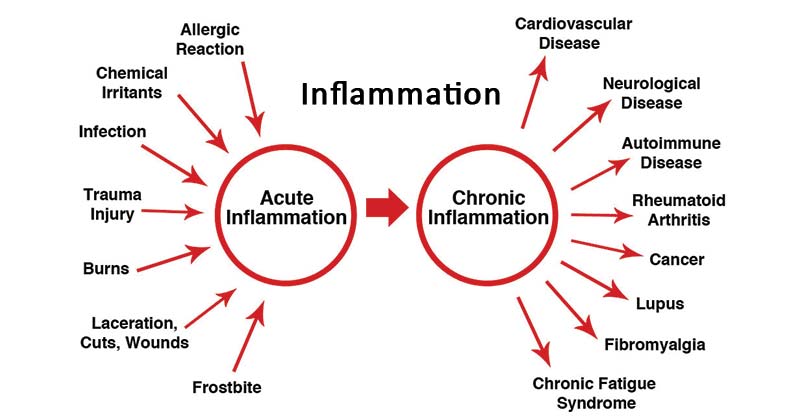Everything you need to know about inflammation
Inflammation is part of the body’s defense mechanism and plays a role in the healing process.
When the body detects an intruder, it launches a biological response to try to remove it.
The attacker could be a foreign body, such as a thorn, an irritant, or a pathogen. Pathogens include bacteria, viruses, and other organisms, which cause infections.
Sometimes, the body mistakenly perceives its own cells or tissues as harmful. This reaction can lead to autoimmune diseases, such as type 1 diabetes.
Experts believe inflammation may contribute to a wide range of chronic diseases. Examples of these are metabolic syndrome, which includes type 2 diabetes, heart disease, and obesity.
People with these conditions often have higher levels of inflammatory markers in their bodies.
Types and symptoms
There are two main types of inflammation: acute and chronic.
Acute inflammation
An injury or illness can involve acute, or short-term, inflammation.
There are five key signs of acute inflammation:
- Pain: This may occur continuously or only when a person touches the affected area.
- Redness: This happens because of an increase in the blood supply to the capillaries in the area.
- Loss of function: There may be difficulty moving a joint, breathing, sensing smell, and so on.
- Swelling: A condition call edema can develop if fluid builds up.
- Heat: Increased blood flow may leave the affected area warm to the touch.
These signs are not always present. Sometimes inflammation is “silent,” without symptoms. A person may also feel tired, generally unwell, and have a fever.
Symptoms of acute inflammation last a few days. Subacute inflammation lasts 2–6 weeks.
Chronic inflammation can continue for months or years. It either has or may have links to various diseases, such as:
- diabetes
- cardiovascular disease (CVD)
- arthritis and other joint diseases
- allergies
- chronic obstructive pulmonary disease (COPD)
- psoriasis
- rheumatoid arthritis
The symptoms will depend on the disease, but they may include pain and fatigue.
Measuring inflammation
When inflammation is present in the body, there will be higher levels of substances known as biomarkers.
An example of a biomarker is C-reactive protein (CRP). If a doctor wants to test for inflammation, they may assess CRP levels.
CRP levels tend to be higher in older people and those with conditions such as cancer and obesity. Even diet and exercise may make a difference.
Causes
Inflammation happens when a physical factor triggers an immune reaction. Inflammation does not necessarily mean that there is an infection, but an infection can cause inflammation.
Acute inflammation
Acute inflammation can result from:
- exposure to a substance, such as a bee sting or dust
- an injury
- an infection
When the body detects damage or pathogens, the immune system triggers a number of reactions:
- Tissues accumulate plasma proteins, leading to a buildup of fluid that results in swelling.
- The body releases neutrophils, a type of white blood cell, or leukocyte, which move toward the affected area. Leukocytes contain molecules that can help fight pathogens.
- Small blood vessels enlarge to enable leukocytes and plasma proteins to reach the injury site more easily.
Signs of acute inflammation can appear within hours or days, depending on the cause. In some cases, they can rapidly become severe. How they develop and how long they last will depend on the cause, which part of the body they affect, and individual factors.
Some factors and infections that can lead to acute inflammation include:
- acute bronchitis, appendicitis and other illnesses ending in “-itis”
- an ingrown toenail
- a sore throat from a cold or flu
- physical trauma or wound
Chronic inflammation
Chronic inflammation can develop if a person has:
Sensitivity: Inflammation happens when the body senses something that should not be there. Hypersensitivity to an external trigger can result in an allergy.
Exposure: Sometimes, long-term, low-level exposure to an irritant, such as an industrial chemical, can result in chronic inflammation.
Autoimmune disorders: The immune system mistakenly attacks normal healthy tissue, as in psoriasis.
Autoinflammatory diseases: A genetic factor affects the way the immune system works, as in Behçet’s disease.
Persistent acute inflammation: In some cases, a person may not fully recover from acute inflammation. Sometimes, this can lead to chronic inflammation.
Factors that may increase the risk of chronic inflammation include:
- older age
- obesity
- a diet that is rich in unhealthful fats and added sugar
- smoking
- low sex hormones
- stress
- sleep problems
Long-term diseases that doctors associate with inflammation include:
- asthma
- chronic peptic ulcer
- tuberculosis
- rheumatoid arthritis
- periodontitis
- ulcerative colitis and Crohn’s disease
- sinusitis
- active hepatitis
Inflammation plays a vital role in healing, but chronic inflammation may increase the risk of various diseases, including some cancers, rheumatoid arthritis, atherosclerosis, periodontitis, and hay fever.


Leave a Reply
Want to join the discussion?Feel free to contribute!